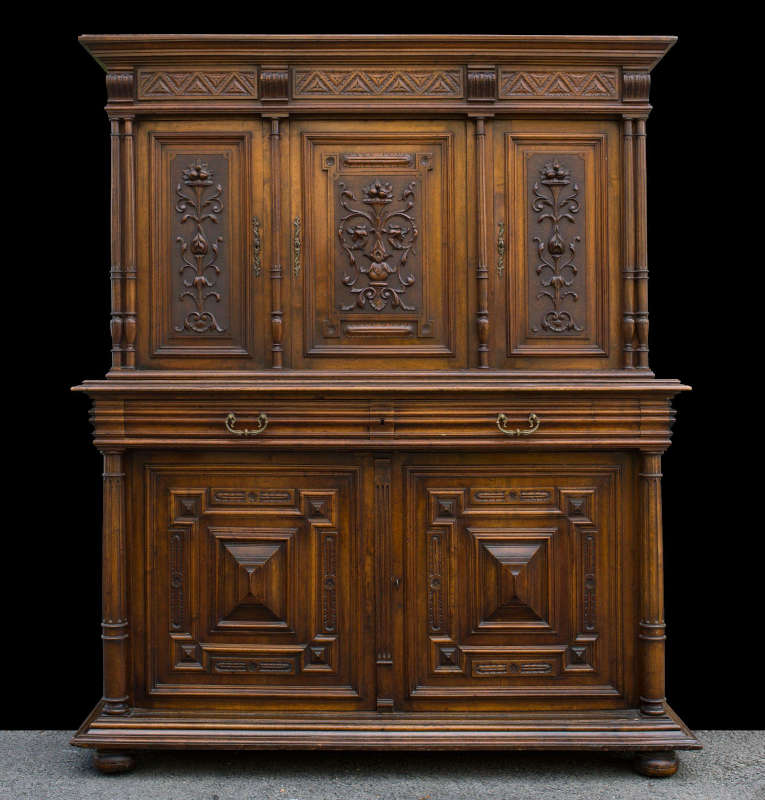If you need to know how to date antique furniture by feet alone, then we’re here to help.
Here is our comprehensive guide for how to date antique furniture by feet:
Ball feet
If the feet are simple round ball shapes, this style dates from the early 1600s and continued deep into the 1800s
If the feet are simple round ball shapes, this style dates from the early 1600s and continued deep into the 1800s.
Usually chests and sideboards have ball feet - these were very prevalent in early Baroque antiques. Other ball feet variations include:
- Onion: With the wider, bulbous shape reminiscent of an onion or melon, sometimes on a small base, these were used on heavier pieces during the Renaissance and well into the 1700s
- Turnip: Also known as tulip feet, these are bulb shaped but with a thinner neck, often a ring on top and then thinning down at the bottom, with a rounded base. Often found on 17th century late Jacobean antiques and also in the mid-19th century
- Bun: Slightly flatter and wider versions of ball feet, dating from the 1600s to 1800s

× 
Animal feet
Feet resembling animal shapes were common throughout the 17th and 18th centuries
Feet resembling animal shapes were common throughout the 17th and 18th centuries:
- Ball and claw: Look like a bird’s claw clasping a ball, often in intricately carved wood or with a metal claw and glass ball. Commonly found on tables and stools, this style was first introduced in the 1700s and remained popular. See below an example of an antique armchair with ball and claw feet from our collection

× 
Carved into the shape of hooves, usually deer hooves, this Baroque style developed in the late 1600s and was still used throughout the 1700s
- Dolphin: Also dating from the 1700s, the feet have been carved into fish heads. On some antiques, the design continues up the table legs and on chairs, some arms may have matching dolphin patterns
- Hoof: Carved into the shape of hooves, usually deer hooves, this Baroque style developed in the late 1600s and was still used throughout the 1700s
- Trifid: Carved into three toes and often at the end of cabriole legs, these date from the 1700s
- Monopodium: Similarly paw shaped and often resembling lion paws. Dating from the late 1700s and popular throughout the next century too, they were used on single-base tables originally, but also chairs and sofas
Tapered cylinder-shaped feet
Arrow, cylindrical and spade feet look quite similar:
- Arrow: Popular in the mid-1700s, these are shaped like triangular cylinders with a ring separating them from the rest of the legs
- Cylindrical: Similar to arrow feet but widening out slightly before tapering down again towards the bottom. They date from the late 1700s and early 1800s
- Spade: These are more rectangular versions of arrow or cylindrical feet, wide at the top and narrower below, dating from the mid-1700s and still popular in the early 1800s
Bracket feet
From the 18th century, feet resembling brackets, often on chests, may look simple but are strong and practical - more ornate versions, also from the 1700s, include:
- Ogee: Similar but with an extra curve to form an S-shape
- French: Thinner than standard bracket or ogee feet and usually tapered, these curve outwards slightly
Block feet
The final main type of feet is the basic block, dating from about 1600 to 1800
The final main type of feet is the basic block, dating from about 1600 to 1800. These are also known as Marlborough feet as they’re often at the bottom of straight Marlborough legs.
If you’re still trying to work out how to date your antique furniture by its feet, here are a few more types:
- Trestle: The oldest feet style on our list, dating back to the Middle Ages. Using both vertical and horizontal posts, they form a T-shape
- Whorl: These have a spiral shape near the bottom and became popular in Rococo style antique furniture after their creation in the late 1600s
- Toupie: Used from the mid-1600s onwards, the feet resemble spinning tops
- Pad: From the early 1700s, the flattened oval feet rest on cylindrical disks

× 
These are the most common examples for how to date antique furniture by feet.
Another way for how to date antique furniture by feet is comparing it to other pieces you already know the time period of.
By evaluating the condition, or identifying the use of similar materials, shapes, patterns and production techniques, the trained eye can work out how to date antique furniture by the feet.
If you would like to know more about how to date antique furniture, please contact us or feel free to browse our collection.